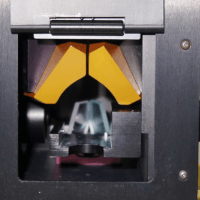FTIR Spectrometry
Fourier Transform Infra-Red (FTIR) analysis uses wavelengths of light from the edge of the visible spectrum (750nm) up to 1mm. This wavelength range can be absorbed by the molecular bonds of a compound. Measuring which wavelengths are absorbed or transmitted by a sample (and how much) gives an indication of what molecules are present. The resulting data is Fourier transformed to give a spectrum that can be used for analysis.
The FTIR spectrum is broken down into three separate components:
- Near Infra-red, 12,500 – 4,000 cm-1 (1 – 2.5μm).
- Mid Infra-red, 4,000 – 400 cm-1 (2.5 – 25μm).
- Far Infra-red, < 400 cm-1 (> 25μm).
While Near and Mid-Infrared are perhaps the most common forms of analysis, instruments are available which cover the entire spectrum of Infra-red analysis.
FTIR spectra are normally reported in terms of wavenumbers rather than wavelength. Wavenumbers are defined as the number of wavelengths per unit distance, normally per cm (cm-1)
To convert from wavenumbers to wavelength in nm, divide 10,000,000 by the wavenumber.
